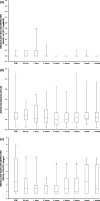Pharmacological Treatment of Presbyopia by Novel Binocularly Instilled Eye Drops: A Pilot Study
- PMID: 27168149
- PMCID: PMC4909677
- DOI: 10.1007/s40123-016-0050-x
Pharmacological Treatment of Presbyopia by Novel Binocularly Instilled Eye Drops: A Pilot Study
Abstract
Purpose: The feasibility, in terms of safety and potential efficacy, of a new drug combination for binocular use as a noninvasive pharmacological solution for treating presbyopia was examined.
Methods: Fourteen emmetropic presbyopic subjects (28 eyes) were given one drop of the preparation under study in each eye. For each patient, the uncorrected distance visual acuity, uncorrected near visual acuity, near and far refraction, best corrected visual acuity, best corrected far-near visual acuity, photopic and scotopic pupil size, Schirmer's test, endothelial cell count, intraocular pressure, keratometry, pachymetry, and anterior chamber depth were all performed or assessed prior to the administration of the eye drops and then 0.5, 1, 2, 3, 4, and 5 h, 1 week, and 1 month post-administration prospectively in each eye and binocularly.
Results: The results showed that near uncorrected visual acuity improved by about 2-3 lines from baseline in each eye and binocularly. There was no degradation in uncorrected far vision in each eye and binocularly in any patient. Refractive measurements performed in this study showed there was a maximum myopic shift of just 0.5 D that progressively reduced and disappeared at 4 h.
Conclusion: The new topical drug treatment analyzed herein significantly improved near vision without affecting far vision. This binocular pharmacologic treatment of presbyopia has the potential to ameliorate the reading vision of presbyopes and possesses the advantages of a nonmonovision therapy. A randomized, controlled, double-masked clinical trial with a twice-a-day treatment schedule is ongoing at our institution.
Funding: This study was supported in part by the Spanish Ministry of Health, Instituto Carlos III, Red Temática de Investigación Oftalmológica (OFTALRED), and Fundación Oftalmológica Vejarano (Popayán, Colombia).
Keywords: Accommodation; Administration; Binocular; Combination; Drug therapy; Ocular; Ophthalmic; Presbyopia; Vision.
Figures




References
-
- U.S. Census Bureau. International data base of world population by age and sex (year 2015 selected). https://www.census.gov/population/international/data/idb/worldpop.php. Accessed 26 Jan 2016.
-
- Charman WN. Developments in the correction of presbyopia. II: Surgical approaches. Ophthal Physiol Opt. 2014;34(4):397–426. - PubMed
-
- Abdelkader A. Improved presbyopic vision with miotics. Eye Contact Lens Sci Clin Pract. 2015;41(5):323–7. - PubMed
-
- Glasser A. Accommodation: mechanism and measurement. Ophthalmol Clin N Am. 2006;19:1–12. - PubMed
LinkOut - more resources
Full Text Sources
Other Literature Sources

